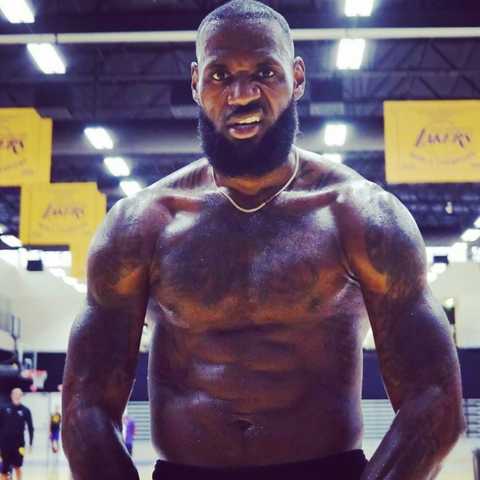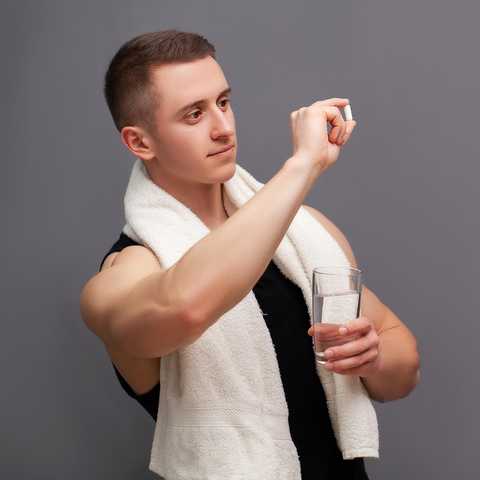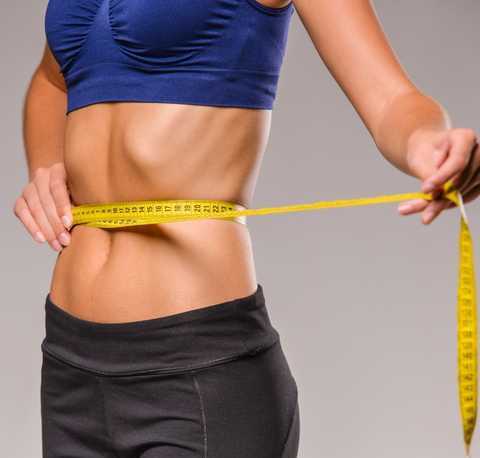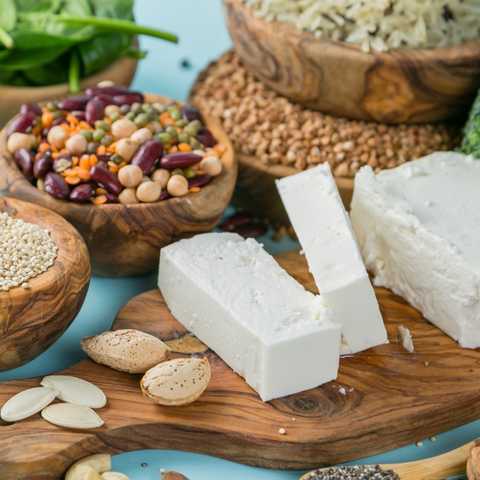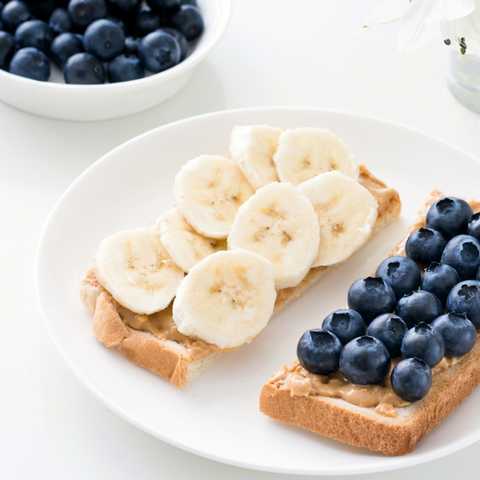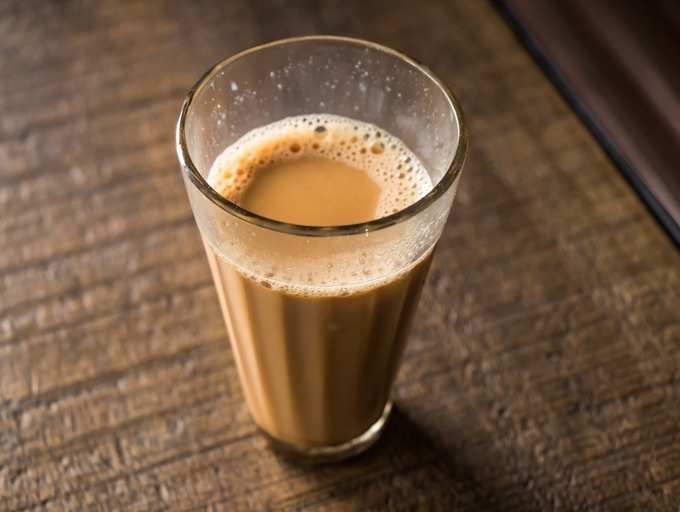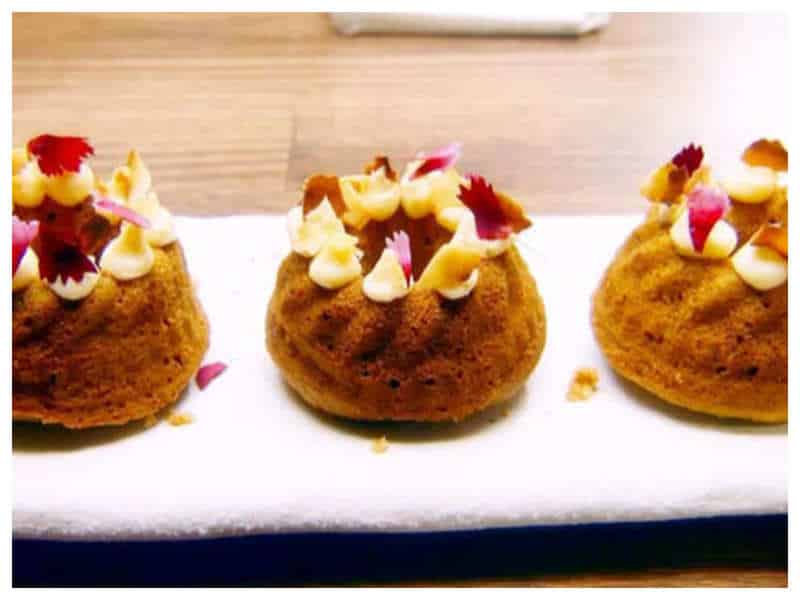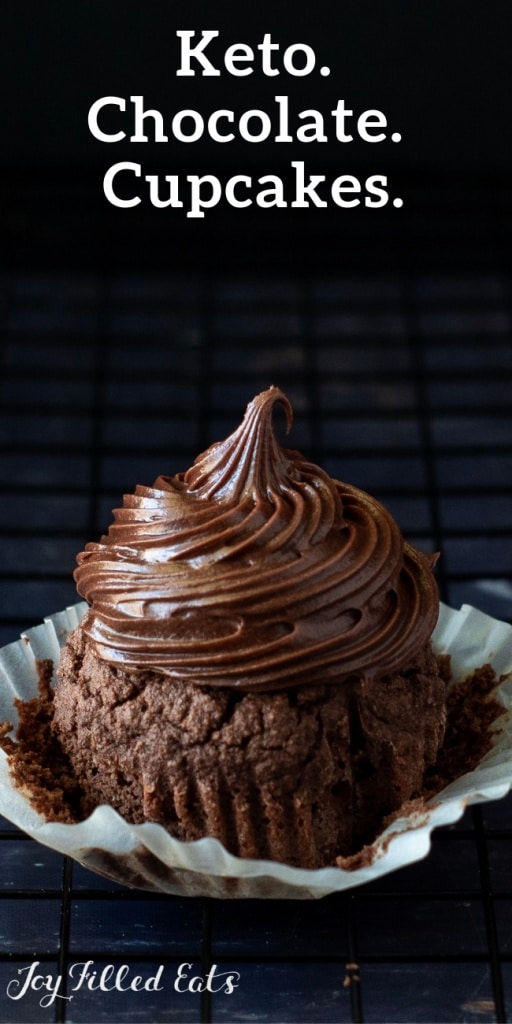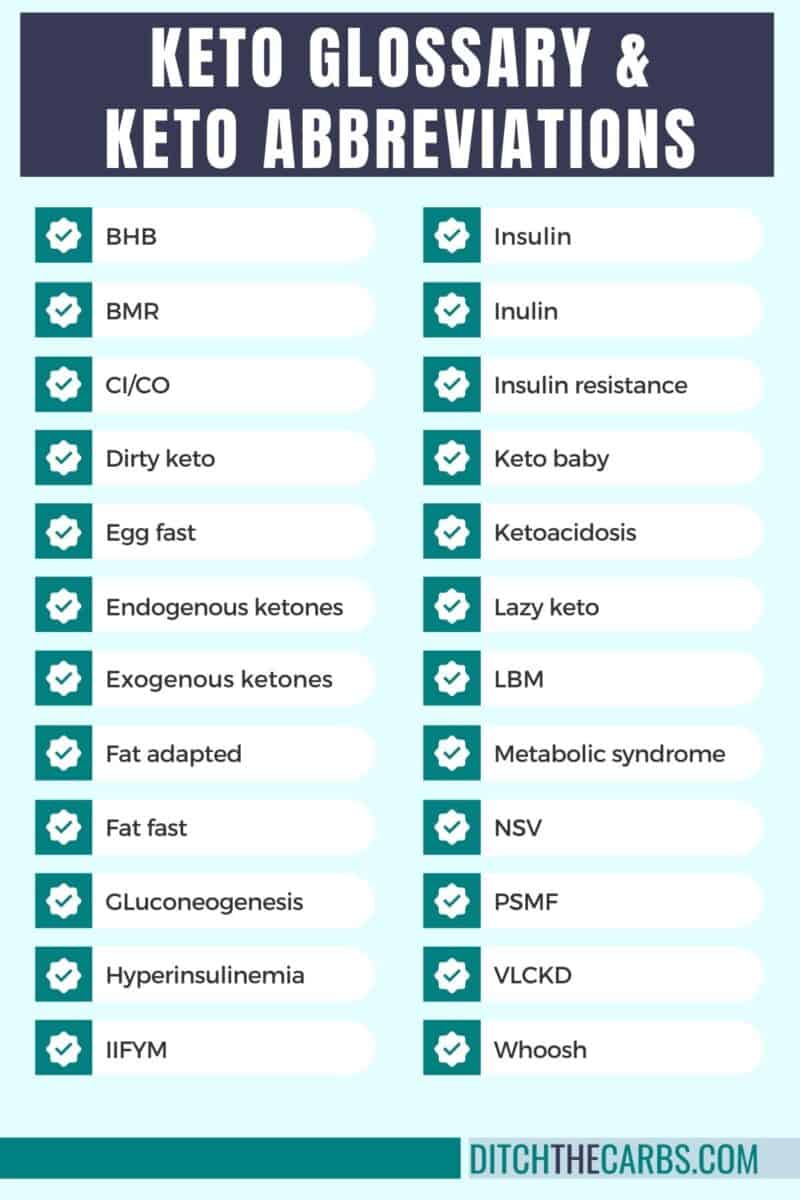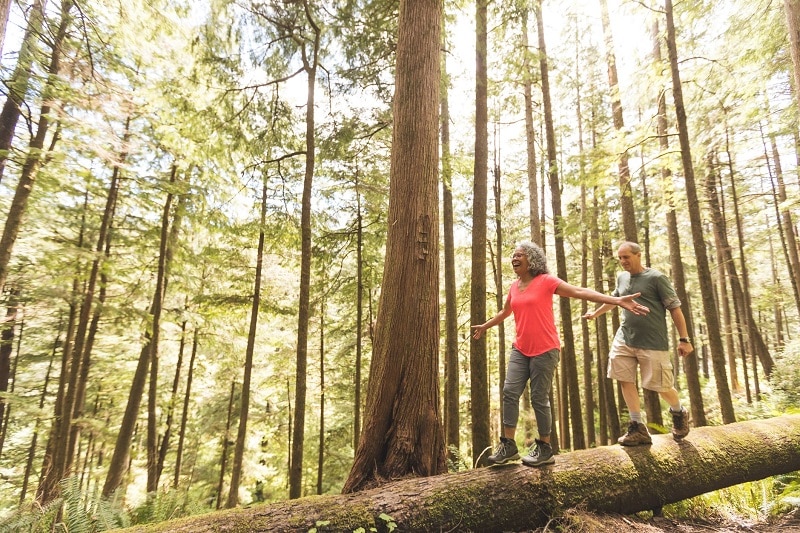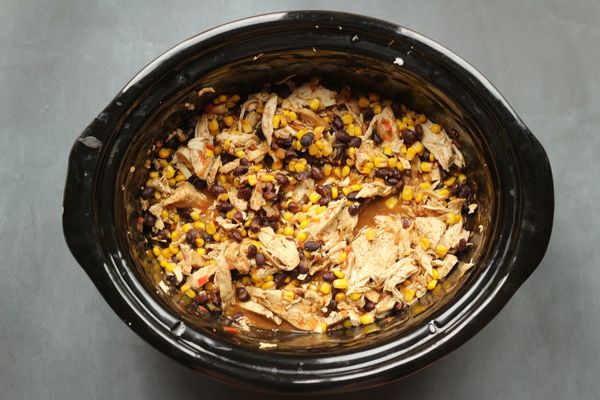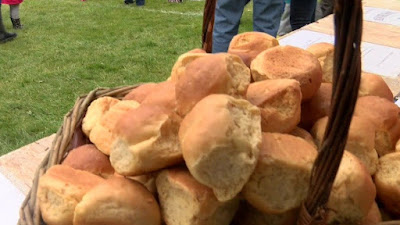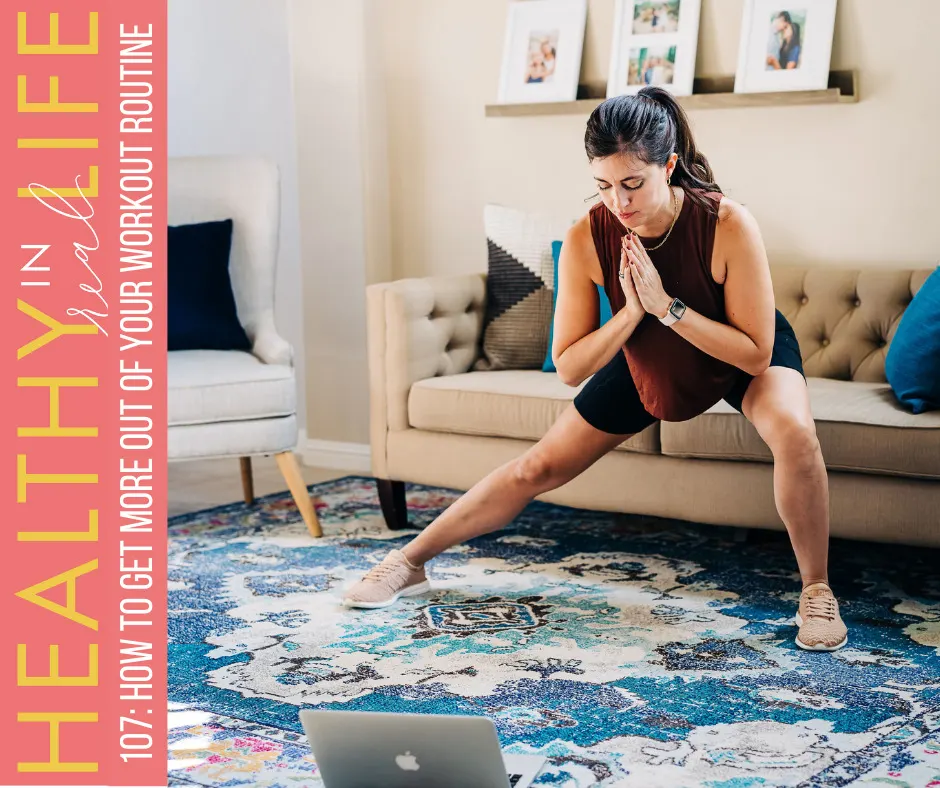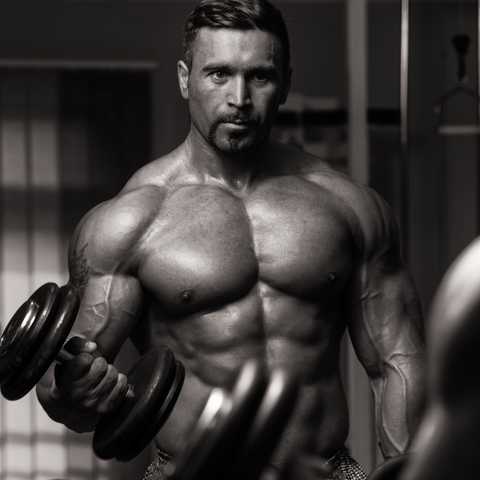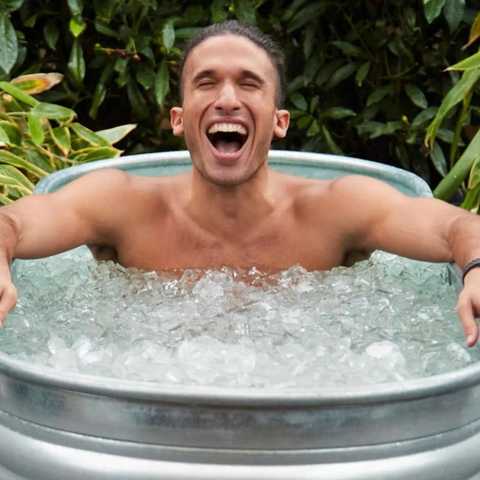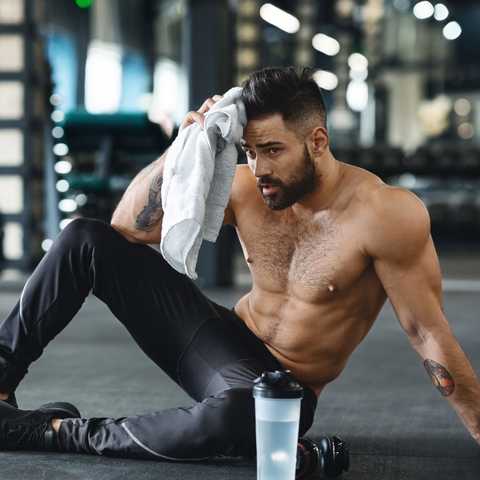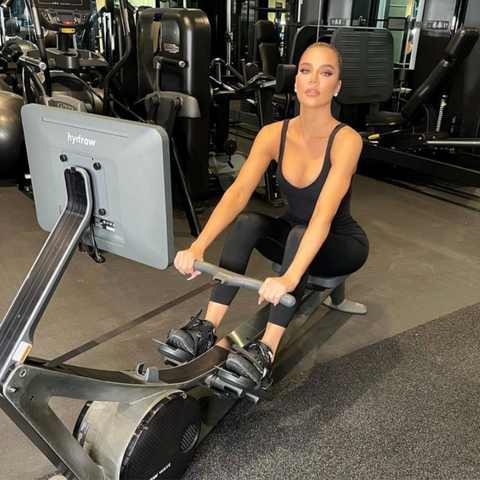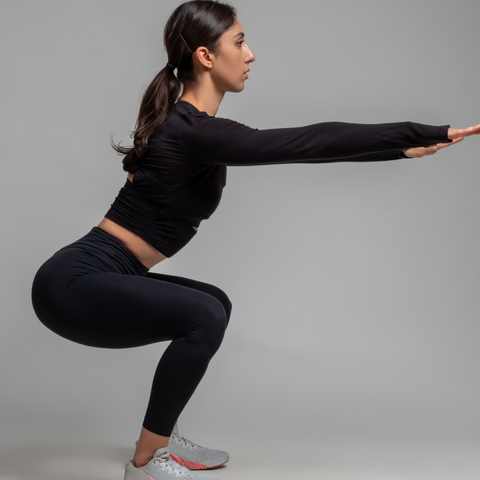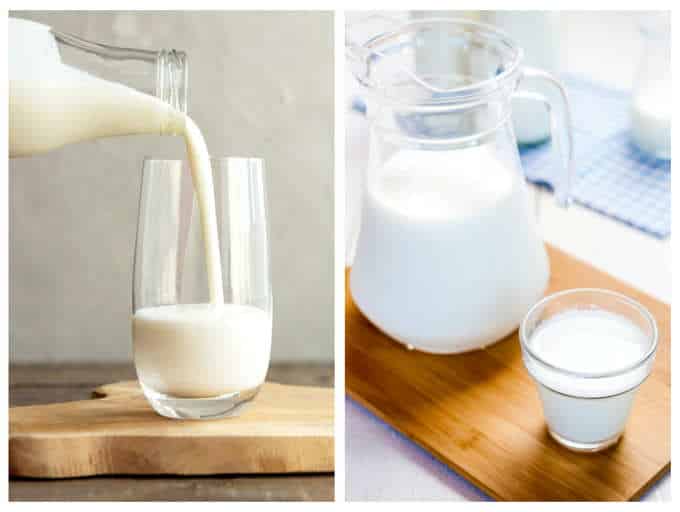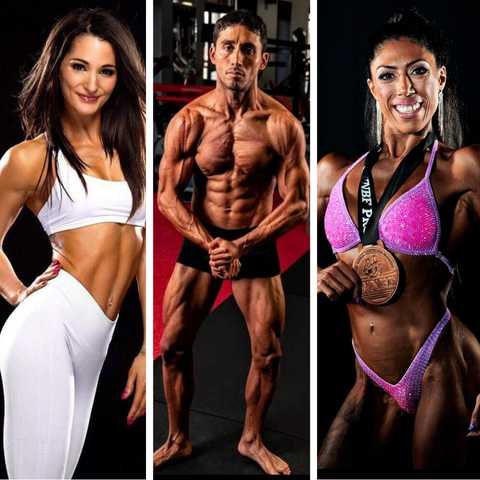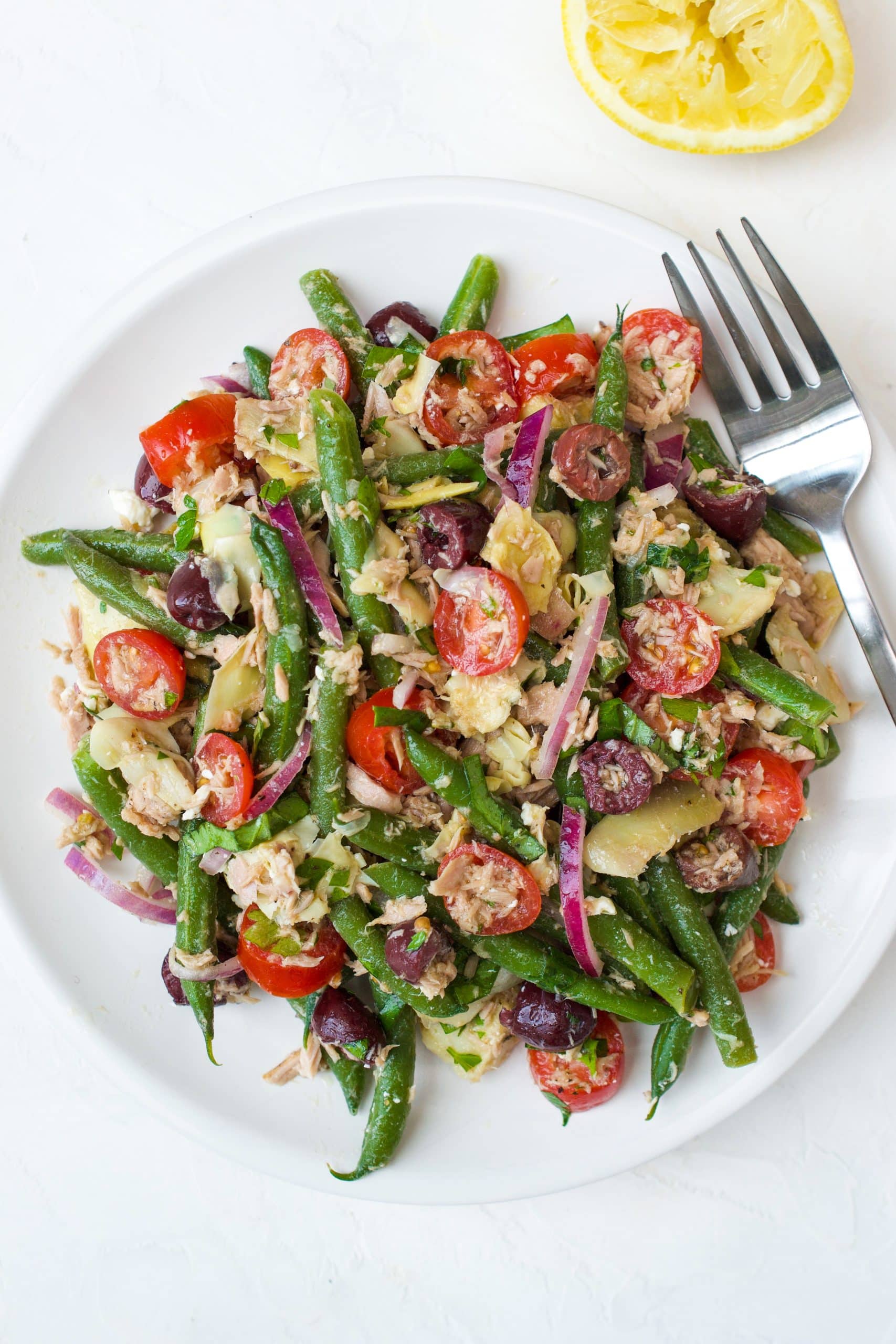But regardless of how you feel about non-gym workouts, sometimes the only option you have is to work out at home, or not work out at all.
And when faced with these two choices, working out at home wins every time. However, the most crucial aspect of a successful at-home workout is knowing what exercises to do to improve strength and muscle mass for each muscle group.
One muscle group you may have questions about is the quads, a group of four muscles that sit on the front of the upper thigh. Learning how to best activate the quads is important, as developed quads are becoming the biceps of the lower body. Muscular quads indicate you have a healthy, strong body.
Beyond aesthetics, the quad muscles also play a massive role in performance and health. With a muscle group this important, it’s crucial that you learn how to activate them with an at-home workout, because there will come a time when you need to get your sweat on without leaving the house.
Table of Contents:
- What Are The Quad Muscles?
- Function Of The Quadriceps Muscles
- The Best At Home Quad Workouts
- Programming Tips For At Home Quad Workouts
- Variables for At Home Quadricep Workouts
- The Best Quad Exercises At Home
- Benefits Of Quad Workouts

What Are The Quad Muscles?
The quadriceps muscles are a large muscle group that includes four muscles that sit on the upper leg. It includes the three vastus muscles and rectus femoris.
- Vastus Intermedius: The vastus intermedius sits on the front side of the upper two-thirds of the femur.
- Vastus Medialis: The vastus medialis is on the medial side of the femur (inner thighs) and runs up the femur. At the bottom of the vastus medialis sits the vastus medialis oblique (VMO), which crosses the knee and controls the placement of the patella¹. Weak quads are often the cause of injuries at the knee joint and are usually due to weak VMO, making vastus medialis exercises essential for any training program.
- Vastus Lateralis: The vastus lateralis sits on the most lateral side of the thigh.
- Rectus Femoris: The rectus femoris runs from the knee joint all the way up the femur and crosses the hip joint. In this capacity, it also serves as one of the hip flexors.
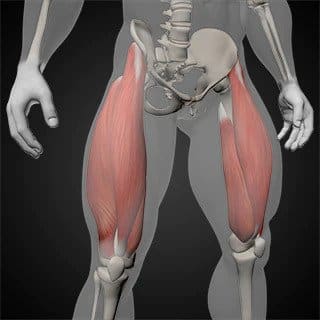
What Are The Functions Of The Quadriceps Muscles?
All of the quadriceps muscles eventually merge into the quadriceps tendon, which becomes the patellar ligament. This allows all four muscles to contract to extend the knee joint and straighten the leg during leg extension.
As mentioned, the rectus femoris travels up the femur and crosses the hip making the quadriceps a biarticular muscle, meaning it crosses two joints. This is what provides the quadriceps with the ability to act as a hip flexor.
The Best Quad Workouts At Home
It’s difficult to provide a single quad workout at home since everyone’s strength and fitness levels vary. Further, unlike at the gym, you don’t have all of the machines and equipment, like the leg press and barbells, to design an entire workout program.
This means you may be much better off performing an entire at home leg workout, rather than one specific to the quadriceps.
However, if quad growth is your primary goal and you want a routine you can do at home that’s dedicated to this muscle group, we’ve got a great quadriceps workout routine to follow. Stay tuned after the workout as we’ll go through step-by-step directions for each exercise.
|
Exercise |
Sets |
Reps |
|
Squat Jumps |
5 |
5 |
|
Walking Lunges |
1 |
50 |
|
Cossack Squats |
3 |
RPE 8 |
|
Bulgarian Split Squat |
3 |
RPE 8 |
|
Split Squat |
3 |
RPE 8 |
|
Bodyweight Squat |
1 |
Failure |
At Home Quad Workout Programming Tips
There are a few things we’d like to touch on regarding programming quad workouts at home. First, including strategies such as Time Under Tension (more on this later) and RPE are good approaches for progressive overload at home.
Target an RPE of 8 for most of the exercises in our workout, which should mean you’re close to fatigue but still have 1-2 reps left in the tank. Once that becomes easy, utilize time under tension, which involves slowing your movements way down.
We’ve supplied you with one workout, but you can use this as a formula for building additional quad workouts if you want more variety.
For example, pistol squats aren’t in the routine, but if you’re advanced enough, you may want to either add it in or swap it in place of a different exercise, like Bulgarian split squats. Another idea is moving bodyweight squats up to the beginning of the workout and ending your program with a plyo move like squat jumps.
The point is that even though you’re more limited in what you can do at home compared to a gym, you still have plenty of options. And if you have access to a resistance band or dumbbells, it opens the door for you to further continue progressing.
Have fun getting creative and building off the routine we just highlighted!
At Home Quad Workout Variables
The best home quad workouts include exercises that focus on knee flexion, as this requires extension of the knee joint. When there is more flexion, more extension will follow.
If possible, there should also be minimal hip flexion. When the hip flexes, the posterior muscles (hamstrings and glutes) are recruited to help extend the hips.
For example, compare the front squat vs back squat. The front squat has minimal hip flexion, while the back squat has significantly more. This doesn’t necessarily mean the quadriceps won’t be utilized to the same degree in the back squat, but it opens up more possibility for the hamstrings to overcompensate.
The 8 Best Quad Exercises For At Home Workouts
Now, that you have the workout, it’s time to go over how to perform the best quad exercises you can do at home. Proper form is crucial when doing these, so be sure to pay attention to the instructions and spend the time needed to practice.
This best home quad exercises list will consist of exercises using just your body weight that do not require any extra equipment. If you have equipment available at home, feel free to add some external loading, such as dumbbells or resistance bands.
1. Bodyweight Squat:
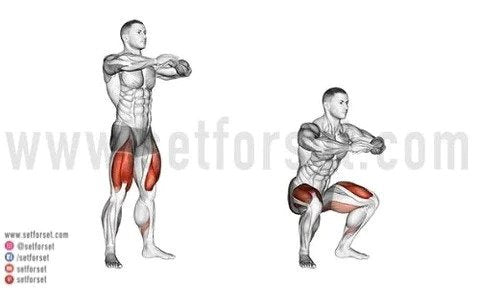
Consider the bodyweight squat to be the No. 1 at home quad exercise. It is the primary movement to build strength in your quads and entire lower body. Even if you are fit enough to knock out a ton with no rest, they should always play a part in your routine, even as a workout finisher or in a circuit.
If you do need to develop strength, the bodyweight squat will build the lower body power necessary to move on to more complex exercises such as the pistol squat. And if your at-home workout routine is temporary, continuing to do the squat will prepare you for when you return to the gym.
How to do a Bodyweight Squat:
- In a standing position, start with your feet shoulder-width apart. You can go slightly wider or narrower depending on your body structure. Position your toes slightly turned out.
- Push your hips back and let your upper body start to drop. Keep your back straight and tight with your scapula pulled back.
- As you descend, allow your knee joint to drift forward, but keep it over your feet the whole time. Do not let the knee joint drift inward or outward.
- As you descend, try to have your shoulders drop straight down in a vertical line. Continue until the top of your thighs are parallel (or below parallel), and then ascend.
- You can keep your arms forward for extra balance.
2. Cossack Squat (Archer Squat):
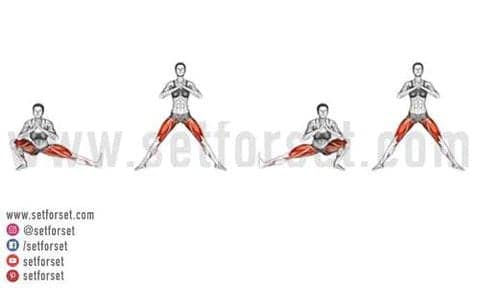
The Cossack squat, aka archer squat, is an intense squat variation that transfers a higher majority of your body weight to one leg.
Using a stance that’s about one and a half to two times wider than shoulder-width apart, you will squat down to one leg while rotating the other foot to its heel.
How to do the Cossack Squat:
- Begin with your feet 1.5-2x shoulder width apart. This can vary, so play around with the width as you move.
- Standing with legs straight, initiate the movement by lowering laterally down to your left foot. Your torso will likely bend forward, but keep your core tight with your back straight (don’t hunch over).
- As you bend your left knee to place your weight on your left foot, keep the right leg straight and then rotate it externally so that the foot comes up on its heel.
- Continue lowering laterally until your bent left knee hits a 90-degree angle. Drive the left foot down to propel yourself upward.
- You can choose to either alternate legs every rep or do one side at a time.
3. Split Squat:
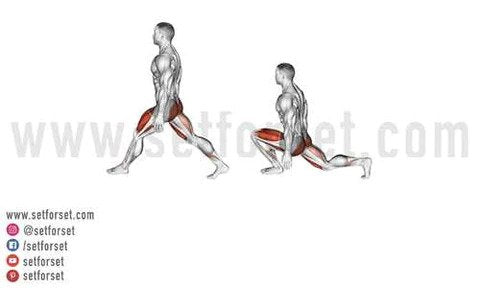
The split squat is basically a lunge that doesn’t move. For whatever reason, the lunge is usually given a lot more attention, even though the split squat is equally challenging, if not more so, due to its ability to let you lift heavier.
Pro Tip: Intensify this quad exercise by shifting your body weight forward, which puts an even greater load on the quadriceps.
How to do the Split Squat:
- Your starting position places you in a split stance, i.e., right leg forward and left leg back. Your torso should be even in the middle of your legs.
- Keeping both feet pointing forward, let your entire body drop straight down in a vertical line. Keep your torso upright and core tight for the entire movement.
- Continue dropping until your back knee touches the ground.
- At this point, the position should look like a kneeling position with your front shin and rear thigh vertical. The knee joint of both legs should be at a 90-degree angle.
- From here, push your body straight up. Do not switch sides. Repeat on the same side for the prescribed amount of reps.
4. Stationary Lunge:
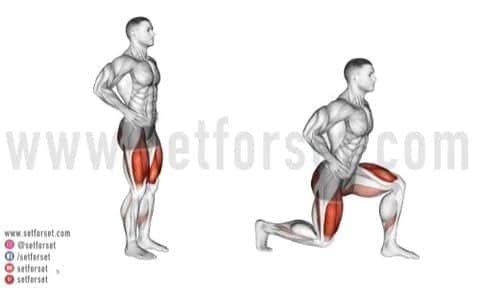
The stationary lunge is one of our favorite lunge exercise variations for incorporating the quadriceps to a higher degree. This is because the front leg must extend to produce power and push the body up.
How to do Stationary Lunges:
- In a standing position with feet hip-width apart, take one large step forward. This will be the exact placement as the split squat position.
- When you lower, your front shin and rear thigh should be vertical, with both knees at a 90-degree angle.
- Once you step out, make sure your toes point forward. Drop straight down with your torso upright. Lower until your rear knee joint lightly taps the floor.
- Next, power up and push your body backward to the original position.
- Switch legs and repeat.
5. Walking Lunge:
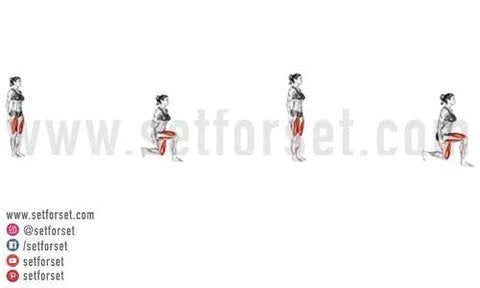
We love the walking lunge for all trainees, regardless of how strong they are. It can be an insane workout finisher or one of your main quad exercises. As the name suggests, it simply refers to performing lunges continuously in one direction, which not only strengthens the lower body but also adds a stability aspect.
There are numerous ways to program these. Because bodyweight exercises are usually easy for many people, one option is to use walking lunges to pre-fatigue the lower body muscles.
To do this, perform an increasing amount of walking lunges before you start every session. For example, in week one, perform 50 walking lunges and your quad workout. For week two, increase your walking lunges to 75, and in week three, ramp it up to 100, keeping your quad workout the same.
This is an easy way to always ensure you’re using progressive overload. Even if you don’t perform more reps in the quad workout section, your volume still increases due to the lunges.
How to do Walking Lunges:
- The starting position is precisely like the stationary lunge as you begin by taking a giant step forward. Lower in the same manner until your rear knee grazes the floor.
- Next, push with your rear leg and use your forward leg to pull your body forward.
- Return to your standing position with both feet next to each other. Switch legs and step forward again.
6. Bulgarian Split Squat:
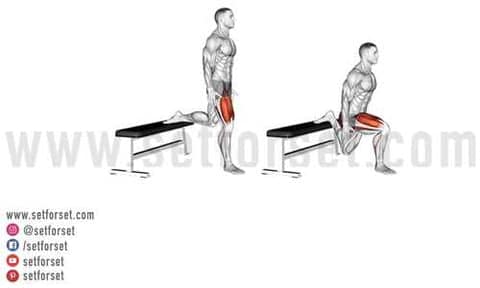
The Bulgarian split squat is notorious for being a challenging, quad-building exercise.
It’s a split squat position, but the rear leg is raised, with the top of the foot resting on a raised structure (box, chair, couch), which takes it out of the equation. This leaves all of your body weight to be lifted by the forward leg muscles.
With this exercise, it’s important to take some time to find your starting position before you begin doing your reps.
How to do the Bulgarian Split Squat:
- You will need some sort of structure to rest your back foot. It should be around the same height as a bench.
- Stand a few feet in front of the bench, facing away. Lift one leg back so you can rest the foot on top. Place the top of your foot on the ledge, so about half of it is hanging off. This allows for ankle mobility as your body descends.
- Step your other foot forward so that you are roughly about 3 feet away. With your foot pointing straight ahead, lower down while keeping your torso upright. Drop so your front shin stays vertical while you keep your back knee extended with a slight bend.
- When you get to the bottom of your rep, your front knee joint should have a 90-degree angle with the top of your thigh parallel to the ground.
7. Squat Jump:

The squat jump is a great quad move that also serves as a plyometric exercise. It requires you to produce enough lower body power to propel your body in the air.
This increases the power production in your quadriceps, which will translate to an improvement in overall strength and function.
How to do the Squat Jump:
- Get in a squat starting position.
- Drop down into a full squat position, and power as hard as you can as you come up. You can also use your arms for momentum.
- As you come off the ground, keep your torso straight and attempt to get as high as you can. As you come down, be sure to follow good landing mechanics.
- As your foot lands, immediately drop into a partial squat to soften the landing.
8. Pistol Squat:
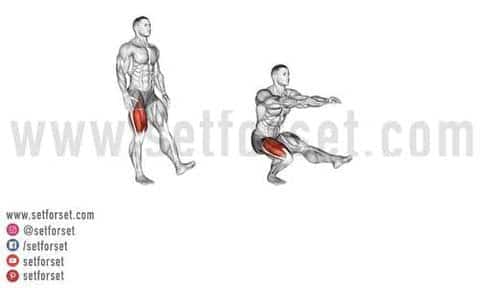
The pistol squat is an advanced single-leg squat position that is extremely tough.
More often than not, it will require time to work through different progressions before you’re ready for it. If you’re not ready for the full pistol squat, there are several progressions to do first.
Your first progression is the Bulgarian split squat, as this helps build the strength and stability required. For an added challenge, brace your back foot on a wall to further eliminate any help from the back foot.
Another modification is the assisted pistol squat, in which you perform a full pistol squat using some support. Use a door or counter of some sort to do this. You can even use a resistance band, rope, or a towel wrapped around a pole.
Regardless of what you use, the same pistol squat form applies. As you improve and build strength, start to rely less on your support. Continue doing this until you don’t need support anymore! Even once you’ve mastered the assisted version, you can continue using it as a quad workout finisher.
How to do the Pistol Squat:
- To perform the full pistol squat, stand with feet shoulder-width apart.
- When ready, raise your left leg straight out in front of you. Begin to sit down, bending your right knee, as you keep your right foot flat and weight centered. Your torso will come down closer to the legs compared to a body squat.
- As you lower on your right leg, continue to lift your left leg and left heel, and if possible, try to grab your toe.
- Sink down until your hips are well below your knee.
Strategies for An At Home Quad Workout
When you’re primarily working with your body weight (or limited dumbbells), it’s a good idea to find alternative ways to make your workouts more challenging.
Here are two strategies to apply to your quad workouts at home.
1) Add Pulses:
Pulses are a term for including “mini-reps” in the middle of every full rep. It’s a very effective way to add time under tension when you don’t have a wide variety of weights. And, you can apply it to most quad exercises.
Usually done with body squats, it would also work very well with a split squat, Cossack squat, Bulgarian split squat, and lunges.
2) Focus on Time Under Tension (TUT):
Time under tension (TUT) refers to the time that your muscle is contracting under a load. The basic theory is that TUT plays an intricate role in muscle hypertrophy as it reflects the amount of work it does.
Basically, more TUT will result in greater overall volume and, ultimately, more muscle growth.
For example, take these two scenarios using the same light weight:
- Trainee 1: Does 10 reps as fast as possible, which only takes 8 seconds.
- Trainee 2: Only performs 1 rep but does it extremely slow, and it takes 16 seconds.
In this scenario, trainee 2 would have better results as he had twice the amount of TUT. These examples are a bit exaggerated, but it’s to better illustrate the principle. In reality, when you have access to a full gym, the idea of TUT begins to lose importance. As long as you are using the appropriate loads, you shouldn’t even be able to do “fast reps.”
Further, if you use TUT, you either won’t be able to use the same amount of weight, or you won’t be able to do the same amount of reps. If you have the appropriate equipment, it makes little sense to purposefully use a smaller amount of weight, and studies have shown its effects are trivial².
That said, TUT is a useful principle when you are in a position where you don’t have access to a full gym, such as at home. Keep this in mind when you are working out, especially if you don’t have access to much weight. Using TUT could be what you need to crank up the intensity.
Benefits Of Increasing Quad Strength
Curious as to why you might want to dedicate an entire workout to your quads? Here are a few reasons why quad workouts are beneficial.
1. Improved Aesthetics:
If you train for aesthetic reasons, quad workouts will quickly become your favorite.
As mentioned, the quadriceps muscle sits on the front of your thigh and is what everyone sees when they look at you. Not only do the quads sit on the front of the thigh, but they are also more pronounced than the hamstrings.
Due to the placement of the four quad muscles, it’s relatively easy to make them defined, at least to some degree. This is because the vastus muscles protrude outward on both sides, specifically medialis and lateralis. They then merge into the knee, making their “bulge” quite obvious.
Further, the quadriceps contain the infamous teardrop muscle, the ball of muscle that sits on the inside of the knee. And nothing looks better than a clearly defined teardrop shape on your front thigh!
2. Increased Performance:
Quadriceps weakness will ultimately lead to a decrease in performance in athletics and primary life function. This is because of its critical role in leg movements, as it is the main extender, and is responsible for primary movements such as jumping, running, and walking.
The quadriceps allow everyday and athletic movements to occur. And when looking at your performance in gym lifts such as the squat and deadlift, you must have strong quads to lift big.
3. Reduced Risk Of Knee Injuries:
The quadriceps are extremely important in supporting a healthy body. As mentioned, the quadriceps provide stability to the knee joint, and the vastus medialis controls the patella’s placement.
Developed quadriceps help prevent injury to the knee. Not doing so will almost guarantee the formation of knee pain.
Grow Your Quads With This At-Home Workout
We just gave you more than enough quad exercises and a killer workout to build a powerful set of legs, wherever you may be. When training with bodyweight exercises, remember your primary goal is to always try to increase the complexity of the exercises.
For quad exercises, this means you should always be striving to do pistol squats with a full range of motion. In addition to increasing intensity, consistency is also going to determine your success.
You can’t grow your quads sitting down!
Looking for a complete leg workout to follow at home? Check out these 5 Killer At Home Leg Workouts to find the perfect one for you!

